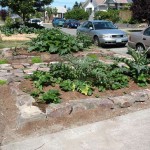From lawns to gardens – removing grass areas to make room for more veggies
Posted on January 31st, 2013 by Andy
If you haven’t had a chance to read it, the New York Times’ Mark Bittman has a good piece on the benefits of converting lawns into gardens. Bittman calls attention to a situation in Orlando, where a couple was threatened with a $500 a day fine for planting vegetables in their front yard. A neighbor had complained about the yard being an eyesore, or rather for looking “like a farm.”
According to the NYT, when faced with a violation from the city, the homeowner “stood outside his polling site during the last election circulating a petition to change the current code, and then appeared on a local TV news station, telling the reporter and any city officials who happened to be watching, ‘You’ll take my house before you take my vegetable garden’.”
“The battle has been raging for months, and the city’s latest proposal is to allow no more than 25 percent of a homeowner’s front yard to be planted in fruits and vegetables,” Bittman writes.
 Fortunately, the city of Seattle has been encouraging residents to plant urban gardens for a number of years as the urban farm movement has taken hold. The mayor and others even recently expanded the number of P-patches in the community where residents can garden if they don’t have their own plots. Still, it wasn’t long ago when homeowners were chastised for not obtaining a $225 street use permit to plant vegetables or flowers in the city-owned property known as parking trips (located between the sidewalk in front of your home and the street). We wrote about the city revising the rules in 2009 after much citizen uproar. The new guidelines are here, and homeowners are free to plant fruits and vegetables in that city-owned parking strip, with some exceptions; for example, the city says don’t plant fruiting cherry, apple or pear trees that may drop fruit and can pose a safety risk to oblivious pedestrians.
Fortunately, the city of Seattle has been encouraging residents to plant urban gardens for a number of years as the urban farm movement has taken hold. The mayor and others even recently expanded the number of P-patches in the community where residents can garden if they don’t have their own plots. Still, it wasn’t long ago when homeowners were chastised for not obtaining a $225 street use permit to plant vegetables or flowers in the city-owned property known as parking trips (located between the sidewalk in front of your home and the street). We wrote about the city revising the rules in 2009 after much citizen uproar. The new guidelines are here, and homeowners are free to plant fruits and vegetables in that city-owned parking strip, with some exceptions; for example, the city says don’t plant fruiting cherry, apple or pear trees that may drop fruit and can pose a safety risk to oblivious pedestrians.
Not every homeowner will want to tear up their front lawns or even devote the time to keep an urban vegetable plot. Let’s face it, vegetable plots can be very time consuming, and not too pleasing to look at during the winter months (the city suggests planting a winter cover crop to keep soil from running off the property and into the storm drains). We think there are certainly benefits to having lawns (think young kids and pets), as long as they’re maintained and grown responsibly. Read more about how we maintain lawns in a ecologically responsible way, including leaving grass clippings on the lawn, using organic fertilizers sparingly, avoiding pesticides (weed and feed products), planting grass seeds that thrive in the Northwest, and going easy on the watering hose.
We’d like to hear from those who are tending vegetable gardens in parking strips. What are you growing in winter months? What are you planning to grow this season? Are there vegetables or fruits that work better than others?
Contact Ecoyards to setup a consultation if you’d like to convert your lawn area into a new garden.
Filed under:Seattle Landscape Maintenance, Vegetable Gardening | Permalink |



